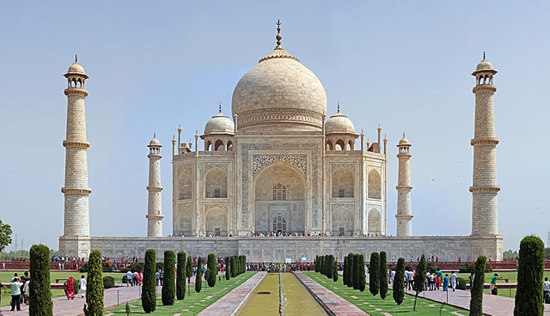The initiative to decide on seven new wonders of the world begun in 2001 and was led by a Canadian-Swiss foundation called New7Wonders. 21 finalists were chosen in January 2006, and then over 100 million votes were cast on the Internet and by phone to decide on the winning 7. The results were announced in June 2007 in Lisbon, Portugal.
The Taj Mahal
According to UNESCO, the ever-famous Taj Mahal had 2 million visitors, 200,000 of which were from overseas, in 2001. Most tourists visit the ancient monument in the cooler October and November months. Due to smog from vehicles in the surrounding city of Agra, the building has started turning slightly yellow, and so the City Council has introduced a 10,000-square-kilometer TTZ, or “Taj Trapezium Zone”, an area in which strict emission standards are applied.
Chicen Itza

Chicen Itza was a city built by the Mayan civilization in what is now the Mexican state of Yucatan. It was one of the Mayan civilization’s largest cities and was likely a Tollans, a mythical great city. The wondrous site attracts an estimated 1.2 million tourists every year. They come to marvel at the city’s architecture and its peculiar features.
During the spring equinox, light falls on the Temple of Kukulcan, which is one of the site’s most iconic structures, in such a way that it casts a shadow resembling a wavy line. This explains the myth of a feathered serpent beast that would ascend the pyramid during this time. Another curious feature of the Kukulcan pyramid is that a handclap at its base echoes in way that sounds like the chirp of a local bird, the Quetzal.
Cristo Redentor (Christ the Redeemer)

Considered the largest Art-Deco statue in the world, although it’s only the fifth-largest statue of Jesus, this massive representation of Jesus of Nazareth stands 39.6 meters tall and, with its arms outstretched, 30 metres wide. Atop Corcovado mountain in Rio de Janeiro, it’s the most important symbol of Brazilian Christianity. It was built over a period of nine years, from 1922 to 1931, and was conceived by local designer Heitor da Silva Costa and the Polish-French sculptor Paul Landowski.
The Colloseum

Originally known as the Flavian Amphitheatre, this circular stadium in the city of Rome, Italy, is the largest ever built by the Roman Empire and certainly one of the most incredible that’s left standing. It used to be the venue for vicious gladiator battles and other epic entertainments. Like the Taj, pollution around the Colloseum has begun to darken its walls. The city of Rome has teamed up with Diego Della Valle, the head of the Tod’s shoe firm, to pursue a $25 million restoration of the building. The restoration work begun in late 2011 and is due to take about three years to complete.
The Great Wall of China

This series of fortifications stretches from Shanhaiguan in the east to Lop lake in the west of China. It is made of stone, brick, wood and tamped earth, and is built in a generally east-west line across what were once the borders between the Chinese Empire and various other warring, nomadic groups. The wall stretches across a distance of about 8,850 kilometers.
Machu Picchu

This Inca city, built in the 15th century, is located in the Cusco Region of Peru. The city ruins and their iconic stepped slopes have been undergoing constant renovation to give visitors a better idea of what the original city might have looked like. What sets the site apart from other Incan remains is that it wasn’t discovered by the Spanish during their conquest, with the result that it was left intact.
Petra

Situated in the Ma’an district of Jordan, this archaeological city is famous for its rock-cut architecture and immense scale. It may have been built as early as 312 BC, and was the capital city for the Nabataeans. Petra is Jordan’s most visited tourist attraction. It’s situated in a naturally beautiful, although arid, region on the eastern flank of Arabah. It was unknown to the western world until 1812, when it was discovered by a Swiss explorer, Johann Ludwig Burckhart.
Featured images:
- License: Creative Commons image source
- License: Creative Commons image source
- License: Creative Commons image source
- License: Creative Commons image source
- License: Creative Commons image source
- License: Creative Commons image source
- License: Creative Commons image source
Post courtesy of Jeff from www.thomascooktours.com – an escorted tours operator that covers all of the various destinations of the New 7 Wonders of the World.





